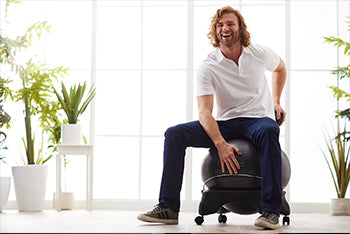What Good Balance Does for Your Body and How to Get It

by: Chris Freytag
The most overlooked and arguably the most important word in health is “balance.” Why? Because this one word says it all! We spend our entire lives trying to keep things in balance, whether it’s our checkbook, our diet, or our time management. As we age, we need to literally improve our physical balance to keep on doing the things we like to do.
Balance training is all the rage these days, and for good reason: Balance is control. Think of a toddler learning to walk and the process he goes through trying to gain the balance to be able to move freely. Once he learns to balance his body, he has control over his movements. The importance of balance doesn’t really change as we get older. Better body balance makes it easier to move and helps prevent injury. But it’s a “use it or lose it” kind of thing, which means it’s important to practice balance at all ages.
Kinesthetic awareness, or the ability to know where your body parts are in three-dimensional space, is required for every movement we make. So it’s not surprising that balance can be learned, challenged, and improved. The agility and strength that comes with learning good balance helps us move smoothly and confidently every day, whether we are doing sports, playing with the kids, chasing down a taxi, or simply walking up the stairs. And, as I mentioned above, a good sense of balance and a strong awareness of where your body is in relation to the things around you can help you react quickly and prevent injuries and accidents.
Balance tools
So how do you keep your balance in good condition? For some people this isn’t simple, but it can be worked on. There are balance training aids out there that can be used in your home or at the health club to improve your core stability, body balance and agility. A few aids that I use regularly are balance pods, balance discs and balance balls.
Balance exercises
Anytime you make the surface underneath you smaller or less stable, you are going to have to use more balance. For example, balancing on one foot gives you a smaller base, and standing on a thick yoga mat can produce a less stable surface. Try these exercises, with or without training aids, to start improving your balance.
- Try standing on one foot and moving your arms around. Once you’ve mastered that, try standing on one foot and bending down to pick something up in front of you (like a book or some keys), all while keeping your balance.
- Traditional lunges and squats are also good ways to test and gain your balance. Focus on keeping your core strong to combat wobble.
- As you continue to work on balance you can up the difficulty by adding arm weights while doing balancing exercises or by doing core exercises on your balance tools.
Of course, if you suspect that you have a severe balance problem then you should speak with a doctor before trying any of these exercises.
Also in Blog

Body Peace & Personal Empowerment

Yoga for Swimmers: Poses for Strength and Mobility







